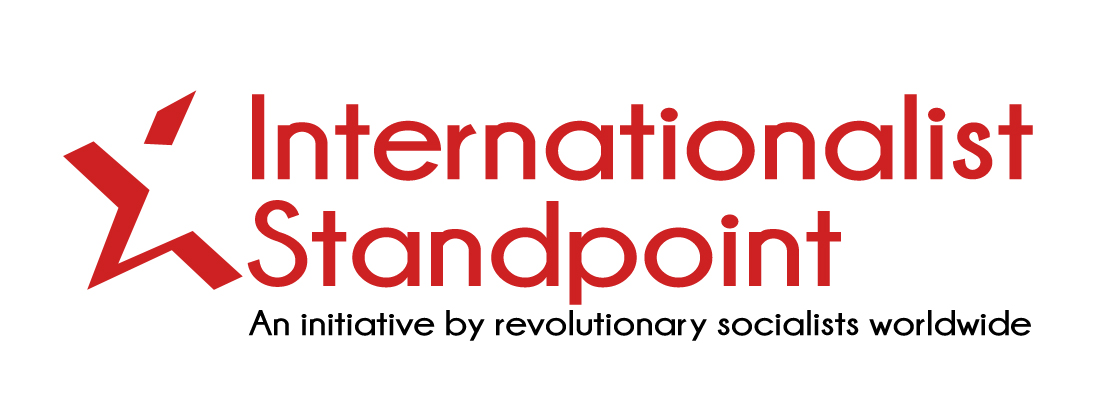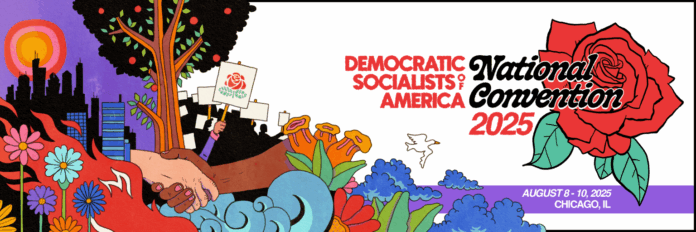We publish below a report on the recent Convention of the Democratic Socialists of America (DSA) written by an Observer at the Convention, Matt Wylder. There is a widespread debate across the left, in the US and internationally, on the prospects for the DSA, and Internationalist Standpoint intends to publish further articles on this issue.
The text of all proposals referenced parenthetically (e.g. R07) are available in this Google Doc, and all vote results are available in this spreadsheet.
Introduction
The DSA grew from a few thousand to 80,000 as the result of the Bernie Sanders 2017 presidential campaign and Trump’s first presidential election. The DSA and the rest of the US left experienced difficulties when Joe Biden and the Democrats took power in 2021. Membership declined through the Biden administration, but has surged again since Trump was re-elected, and it has been infused with enthusiastic solidarity for Palestine.
DSA has a vibrant constellation of “caucuses”, essentially factions or platforms within DSA that advocate shared positions. [Find a useful rubric of the political spectrum of DSA in this report of the Convention].
DSA is organized into regional chapters, usually on the city level, and these chapters are somewhat distinct from the national organization as a whole. Any activist seeking out the precise political balance of the national organization will not find it locally. New York City, for example, is dominated by electorally-focused caucuses of the “moderate” wing. Chicago’s chapter is fairly labor-focused, given the powerful influence of the Chicago Teachers Union in the city’s politics.
DSA’s latest membership surge is predicted by some to reach 100,000 registered members soon, but a relatively small percentage are active cadres in the organization. Most are paper members, or only attend a few meetings. Encouraging member activity is a regular concern of DSA chapters. Meetings are often overly-focused on process over politics, which can be alienating. The distance between the local membership and the cadres can be addressed by a more conscious attempt to bring national debates to weekly chapter life.
DSA has matured since its growth in 2017, though its future is still the subject of debate. Questions that outside observers may have about DSA – what actually is DSA, what is its relationship to the Democrat Party, and with its members in elected positions – are also hot debates within the organization. Through these debates, DSA’s official leadership, as represented by its biannual convention delegations and the National Political Committee (NPC), its leading body between conventions, is evolving to the left. This move to the left is a contradictory process; it is not a generalized movement of all members to the left, and is sparking debate within the organization.
Roughly 1,300 delegates attended this convention. The proceedings were very orderly. DSA members are often very enthusiastic about rules and procedures. In a world where leaders of some left wing organizations act arbitrarily in the name of democracy, consistent procedures can be very helpful. But even the best rules can be misused by those with authority, though this was not the case at the convention. The rules invite some pedantry from the floor, which can slow down proceedings, but it was generally understood that such behavior was less common this year than in the past. The agenda was packed, and debate on each proposal was fairly short, but seemingly more political than in the past. That said, one of the most politically important proposals (R06, discussed below) was defeated procedurally instead of politically, which was disappointing.
Debating the Way Forward
The resolution “Principles for Party-Building” (R07), passed at this convention, provides a useful political snapshot of DSA’s current conjuncture. It describes DSA as a “party surrogate, acting as a party but without a dedicated ballot line” which “fights on unfavorable terrain and is pulled between the necessity of independent political action and using the ballot line of the Democratic Party.” It stresses that DSA must “move away from the Democratic Party ballot line and primaries” and stresses the value in running some independent campaigns. It also recommits DSA “to the project of building a working-class party”.
The resolution’s passage is just as important as the opposition to it. It attempts to thread the needle between independence from and operations within the Democratic Party, and won with 54% of the vote. A sizable minority disagrees for one reason or another, whether advocating a clean break from the Democratic Party, remaining within the Democratic Party indefinitely, or other disagreements.
While the shift to the left is encouraging, factional debates often obscure as much as they clarify, and pressing strategic questions are often not formally discussed. For example, DSA has been able to launch and build the exciting mayoral campaign of Zohran Mamdani, but no organized debate over strategy took place at the convention, which could have prepared DSA members to navigate challenges and disappointments as the Democratic Party is attempting to co-opt Mamdani.
Elections and Elected Officials
DSA has a complex relationship with its endorsed candidates. DSA is not a political party, and most of its elected officials have run on the Democratic Party ballot line with varying levels of active participation by DSA members. Once elected, city council members or members of Congress have much more power than DSA, and trend towards independence. This power imbalance consciously and unconsciously contextualizes debates within DSA over accountability, internal candidate recruitment, and endorsements.
DSA’s endorsed candidates exist on a spectrum. On one end, there are campaigns which are heavily led by DSA members, for example Jake Ephros in New Jersey; on the other end are campaigns only endorsed by DSA.
Zohran Mamdani’s campaign in the New York City Democratic mayoral primaries was largely led by DSA members, but pressure from the Democratic Party, including a phone call from Barack Obama and the hiring of a Democratic Party operative indicate that the Democratic Party may change him more than he changes the Democratic Party.
At the 2023 convention, a left-wing majority won the national leadership, which withheld national endorsement of AOC in 2024 for insufficiently supporting Palestine. Much of the 2025 convention dealt with the implications of this political decision. The “moderate” cacuses, which generally trend towards remaining within the Democratic Party for the foreseeable future, proposed (R06) taking away from the NPC the power to make national endorsements, and to put such endorsements to a referendum by the members (“one member one vote”, or “1M1V”). This was tied to another proposal (CB02) to elect the NPC via 1M1V as well. Politically, this was an attempt by the moderate wing of DSA to circumvent the activist core of the organization as it moves to the left, in hopes that less-active members would endorse candidates with less scrutiny. Both proposals were defeated, the first procedurally, the second with roughly 39% in favor.
Proponents of 1M1V argued that convention delegates represent an insular group out of step with the attitudes of the broader membership and of society as a whole. But 1M1V, had it passed, would have been a step backwards for DSA’s ability to learn collectively through convention debates. A former chapter officer suggested to me that a politicized pre-convention period would be helpful in this respect. Such a change could bridge the gap between delegates and the local chapter membership, and politicize the political debates at the convention itself.
The 2028 Presidential Election
DSA passed by a resolution (R33) in favor of building a coalition to run a candidate for President on the Democratic Party ballot line in 2028. The key text of the resolution is worth quoting at length:
DSA should aspire to build a broad left-labor coalition, composed of labor unions and other mass organizations, which can draft a platform; recruit candidates for federal, state, and local office for the 2026 and 2028 elections; and draft a socialist candidate for the 2028 presidential election. In order to gain real traction and look more like Bernie Sanders’ presidential campaigns than past third-party campaigns, DSA should back a viable candidate in the Democratic presidential primary, such as a nationally known elected official, labor leader, or public figure, who will primarily publicly identify with and promote DSA, socialism, and/or a left-labor coalition rather than the Democratic Party. DSA will advocate for such a coalition to endorse independent and nonpartisan down-ballot candidates as well as candidates running in Democratic primaries.
A counterproposal (R33-A02) which emphasized running an independent Presidential candidate candidate alongside groups like the Green Party and the Party For Socialism and Liberation (PSL) rather than on the Democratic Party ballot line was defeated with 45% in favor. The counterproposal emphasized building a united front to take advantage of “agitational offered by the 2028 presidential elections and the possibility of a May Day 2028 general strike” and generally supported the running of independent candidates. The proposal to run independents in local elections was clear, but it was vague on its strategy towards the presidential elections.
Palestine
Debates on Palestine overlapped with the electoral debates, and the national question was debated as well.
On the electoral front, the convention passed, with 54% in favor, a resolution (R22) which commits DSA to recognizing
“… ‘al-Thawabit’, the principles originally set by the Palestinian National Council in 1977 and repeatedly reaffirmed since, which are the Palestinian people’s right to resistance, the Palestinian right to self-determination, the recognition of Jerusalem as the capital of Palestine, and the right of Palestinian refugees to return to their homeland from the river to the sea”,
The resolution deems candidates who cannot commit to these expectations as ineligible for national or local endorsement.
The resolution included controversial language deeming public opposition to the cause of Palestinian liberation, affiliation with the Israeli state or US-based lobbies, or “knowingly providing material aid to Israel” an expellable offense, subject to a two-thirds majority vote by the NPC. An amendment (R22-A01) to remove language on expulsion was defeated with only 45% in favor.
Some opponents claimed that the expulsion provisions would lead to mass expulsions of members, that members would have to leave their synagogues lest face expulsion, etc. But the language of the resolution – with its emphasis on legislation, votes, public statements, and affiliations to lobbying groups – appears mainly aimed at disciplining electoral figures, not rank-and-file members.
Nevertheless, the debate within the organization will be ongoing. If and when concrete cases reach the NPC, every chapter should dedicate time to structured discussions on the issue. Such discussions would strengthen nation-wide democracy within the organization in order to sharpen the organization and the movement as a whole on questions of Palestinian liberation and electoral strategy.
On the national question, a proposal in favor of a single, secular state in Palestine (R01) failed with just under 30% of delegates in favor. From the point of view of the author, the majority view DSA is in favor of a single state, and the failure of this resolution mainly represents disagreements among one-state advocates rather than the development of alternate positions on the national question (see contentious amendments R01-A01 and R01-A02 for details).
Democratic Congresswoman Rashida Tlaib, a DSA member, spoke at the keynote, and made implicit criticism of AOC for her vote funding the Iron Dome.
Internationalism
The convention featured an “organizational exchange” with dozens of guest organizations, the most notable of which were international organizations. Guests from La France Insoumise, MORENA, PSoL, the Japanese Democratic Socialist Party, among others, spoke alongside US-based labor groups including a reform caucus in the letter carriers union and the Chicago Teachers Union. Jeremy Corbyn sent a video address for a separate session. Members of the Cuban communist party also sent video messages. The number of speakers from various organizations was impressive, and the speakers list became quite long. Hopefully the success of this exchange will lead to its expansion at the next convention.
Much of DSA’s far left has a “campist” perspective on internationalism, seeking to ally with the enemies of US imperialism, regardless of their class basis. One defeated proposal (CR02-A02) directly challenged the campism of the far left, encouraging DSA’s international committee to build comradely relations with democratic and socialist oppositions in “governments that claim to oppose U.S. imperialism, but which continue to repress or exploit their own working class populations.” It was defeated with only 42% in favor.
The proposal also would have encouraged building relationships with a broader spectrum of left-wing organizations. It is a shame that it was defeated, since there are many lessons to learn from the experience of the international left in the past decade and a half. The left internationally is in crisis, either for capitulating to the system or because of sectarianism. DSA faces both challenges.
Organizational
DSA had for years a constitutional ban on members of democratic centralists groups joining the organization. This provision was abolished as part of a large, uncontroversial package, and drew no criticism or comment during the proceedings. This is a largely symbolic change, as democratic centralist organizations have existed “undercover” within DSA for years without challenge. But this change, alongside its shift towards solidarity with Palestine, highlights the evolution of the organization since its explosion in 2017.
Another proposal (R34) committed to creating a committee to investigate updating the existing program. A counterproposal (R34-A01) sought to begin a process to adopt an explicitly revolutionary program. It failed with 44% in favor, and the original proposal for a program committee passed with 74% in favor.
Conclusion
DSA is an evolving organization, and its durability is notable. It has grown and shrunk with the ebbs and tides of the political cycle, but its core remains dedicated and is learning through debate and experience.
Its debates are often factionalized, and the debates on orientation to the Democratic Party are not resolved. The learning process is very slow, which is inevitable given the US’s low experience with political organization. It has not yet been a decade since DSA’s modern era began, and patience is necessary.
That said, DSA’s growth under Trump’s second administration does not mean permanent, uninterrupted gain. If DSA is not able to establish an independent identity, known for conflict with the Democratic Party, it will suffer from crises again.
The fall in membership and the staffing crisis that took place during the Biden years were ultimately a political problem, as DSA struggled to find a strategy under a Democratic administration. Without the organization and its representatives seizing opportunities to enter into conflict with the Democratic Party, the goal of building a new party will be thrown back and the movement as a whole can face a retreat that would have important long-term consequences.
Whatever DSA is today, it will be around for a while, and will likely play some kind of role in the development of a new party or mass organizations in the US. That alone makes participation worthwhile. In the meantime, experience in DSA can give oneself greater confidence in their own principles. It is a useful venue for Marxist to collaborate and sharpen their arguments in debate with comrades with whom they disagree.



